Formula One Safety car
The safety car has found its name in the fact that is it a "regular" car which needs to take car of security. During Formula One races it is sent on track when the race director decides there is a dangerous situation that should be handled with extreme care. When on track, no racing car may pass the safety car in order to control the speeds of the racers. During that time, any overtaking is forbidden while it is allowed to make a pitstop during the period.
While it is a regular car and thus not a single seater, it is vastly slower than Formula One cars. However, the best performing road cars are used to fulfill this task as speeds must not drop too much. Formula One cars rely cooling by moving through air (without an active fan) which at low temperatures may cause the engines to overheat. Tyres on the other hand may cool down and thereby provide less grip.
The first use of the Safety Car in Formula One was at the 1973 Canadian Grand Prix. However, the Safety Car took its place in front of the wrong driver, which placed part of the field incorrectly one lap down. It took several hours after the end of the race to straighten out who the winner actually was. The safety car was only used again 20 years later, in the 1993 Brazilian Grand Prix.
To date, the 1999 Canadian Grand Prix is the only Formula One race to finish behind the Safety Car.
Satefy car 2008 : Mercedes-Benz SL 63 AMG
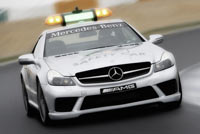 Engine: 6208 cc, V8
Power: 525 bhp (386 kW) Engine: 6208 cc, V8
Power: 525 bhp (386 kW)Torque: 630Nm at 5200 rpm Redline at RPM: 7200 Brakes: ABS, vented disc/vented disc Tires front-rear: 255/35 R19 - 285/30 R19 from Bridgestone Driveline: Rear Wheel Drive Weight: 1750 kg More can be found here. |
Functions and regulations
The FIA safety car is driven by an experienced circuit driver (who is since 2000 Bernd Maylander, a former DTM and Porche supercop driver). It carries an FIA observer capable of recognising all the competing cars, who is in permanent radio contact with race control.
30 minutes before the race start time the safety car takes up position at the front of the grid and remains there until the five minute signal is given. At this point (except under m) below) it will cover a whole lap of the circuit and enter the pit lane.
The safety car may be brought into operation to neutralise a race upon the decision of the clerk of the course. It will be used only if competitors or officials are in immediate physical danger but the circumstances are not such as to necessitate stopping the race. When the order is given to deploy the safety car, all observer's posts will display waved yellow flags and a board "SC" which shall be maintained until the intervention is over. From this time any car being driven unnecessarily slowly, and which is deemed potentially dangerous to other drivers, will be reported to the stewards. This will apply whether any such car is being driven on the track, the pit entry or the pit lane.
The safety car will start from the pit lane with its orange lights illuminated and will join the track regardless of where the race leader is. All competing cars must then form up in line behind the safety and stay close together while overtaking is forbidden. Any car in behind the safety car that is in front of the race leader may pass the safety car when it allows so by lighting up its green lights. These cars will continue at reduced speed and without overtaking until they reach the line of cars behind the safety car. The safety car shall be used at least until the leader is behind it and all remaining cars are lined up behind him.
While the safety car is in operation, competing cars may enter the pit lane, but may only rejoin the track when the green light at the end of the pit lane is on. It will be on at all times except when the safety car and the line of cars following it are about to pass or are passing the pit exit . A car rejoining the track must proceed at an appropriate speed until it reaches the end of the line of cars behind the safety car.
When the clerk of the course calls in the safety car, it must extinguish its orange lights. As of that point the first car behind the safety car may dictate the pace. Green flags will be shown at the track as soon as the safety car is returned to the pitlane.
Each lap completed while the safety car is deployed will be counted as a race lap. If the race ends whilst the safety car is deployed it will enter the pit lane at the end of the last lap and the cars will take the chequered flag as normal without overtaking.
In exceptional circumstances the race may be started behind the safety car. In this case, at any time before the one minute signal its orange lights will be turned on. This is the signal to the drivers that the race will be started behind the safety car. As soon as the green lights go on, the race starts and overtaking is only allowed when a car lost places during that start. The driver may then overtake others to regain his starting position.
Previous safety cars in Formula One
Mercedes-Benz CLK 63 AMG (2006-2007)
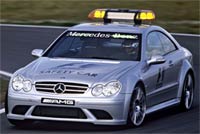 Engine: 6208 cc, V8
Power: 481 bhp (354 kW) at 6800 rpm Engine: 6208 cc, V8
Power: 481 bhp (354 kW) at 6800 rpmTorque: 630Nm at 5200 rpm Redline at RPM: 7200 Brakes: ABS, vented disc/vented disc Tires front-rear: 235/35 R19 - 265/30 R19 Driveline: Rear Wheel Drive Weight: 1600 kg More can be found here. |
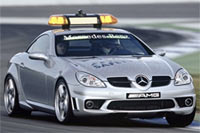 Engine: 5500 cc, V8 Engine: 5500 cc, V8Power: 265 kW/360 hp Torque: 510 Nm Weight: 1370 kg Brakes front: 360 x 22 mm composite brake discs with six-piston fixed callipers Brakes rear: 330 x 26 mm steel brake discs with four-piston brake callipers (All discs are internally ventilated and perforated; the front brakes, which have to deal with particularly high stresses, have specially designed cooling ducts) Tyres front-rear: 235/35 R19 - 265/30 R 19 |
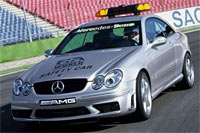 Weight: 1820 kg Weight: 1820 kgEngine: 5439 cc V8 90° Power: 367 bhp / 270 KW at 5500 rpm Torque: 510 Nm / 376 ft lbs at 3000 rpm Valvetrain: 3 valves / cylinder, SOHC Gearbox: 5 speed Automatic Accelleration: 0-100 km/h in 5.3s |
| Weight: 1834 kg Engine: 5439 cc V8 Power: 493.00 hp (362.8 kW) at 6100.00 rpm |
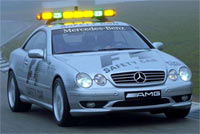 Engine: V8
Power: 265 kW
Engine: V8
Power: 265 kWAccelleration: 0-100km/h in 6s Brakes: 8-piston fixed calliper disc brakes and 380 mm brake discs at the front and 315 mm discs at the rear Tyres front-rear: 255/40 R19 - 285/35 R19 |
No details known
